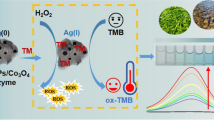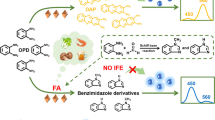Abstract
Chrysoidine, an industrial dye, is a banned chemical for use as a food additive. Studies have shown that excessive ingestion, inhalation and dermal contact with the substance can cause acute and chronic toxicological damage. Surface enhanced Raman spectroscopy (SERS) is a spectroscopic detection technique with high selectivity and sensitivity. In this study, a mixture of silver nanoparticles (AgNPs) and polyethyleneimine (PEI) was used as the SERS substrate at room temperature for the rapid and sensitive detection of Chrysoidine in mirinda soft drink, and PEI could attract Chrysoidine to the hot spot region of the AgNPs and enhance its Raman signal. The characteristic peak of the SERS spectrum of Chrysoidine showed obvious SERS enhancement at 1180 cm− 1, and there was a good linear relationship between the SERS intensity and the concentration of Chrysoidine. The limits of detection (LOD) in both water and mirinda soft drink were determined to be 1.32 µg/L and 5.11 µg/L, respectively. In addition, the average recoveries ranged from 95.65 to 102.08% with the RSDs of 3.41-5.02%. The method can be successfully used for the rapid and sensitive detection of Chrysoidine in mirinda soft drink, which provides a new idea for the detection of Chrysoidine in other different samples.








Similar content being viewed by others
Data Availability
The datasets generated during and/or analysed during the current study are available from the corresponding author on reasonable request.
References
Nurchi VM, Crespo-Alonso M, Biesuz R, Alberti G, Pilo MI, Spano N, Sanna G (2014) Sorption of chrysoidine by row cork and cork entrapped in calcium alginate beads. Arab J Chem 7:133–138. https://doi.org/10.1016/j.arabjc.2013.07.006
Sun W, Xu Q, Liu Q, Wang T, Liu Z (2023) Post-synthetic modification of a magnetic covalent organic framework with alkyne linkages for efficient magnetic solid-phase extraction and determination of trace basic orange II in food samples. J Chromatogr A 1690:463777. https://doi.org/10.1016/j.chroma.2023.463777
Xie Y, Chen T, Cheng Y, Wang H, Qian H, Yao W (2014) SiO2@Au nanoshells-based SERS method for detection of sunset yellow and chrysoidine. Spectrochim Acta A Mol Biomol Spectrosc 132:355–360. https://doi.org/10.1016/j.saa.2014.04.096
Sandhu P, Chipman JK (1991) Lack of release from hepatocytes in vitro or excretion in vivo of mutagenic chrysoidine metabolites. Toxicol Lett 58:43–50. https://doi.org/10.1016/0378-4274(91)90189-D
Yang B, Hao F, Li J, Wei K, Wang W, Liu R (2014) Characterization of the binding of chrysoidine, an illegal food additive to bovine serum albumin. Food Chem Toxicol 65:227–232. https://doi.org/10.1016/j.fct.2013.12.047
Wang Q, Xu Z, Zhao Y, Zhangsun H, Bu T, Zhang C, Wang X, Wang L (2021) Bio-inspired self-cleaning carbon cloth based on flower-like Ag nanoparticles and leaf-like MOF: a high-performance and reusable substrate for SERS detection of azo dyes in soft drinks. Sens Actuators B Chem 329:129080. https://doi.org/10.1016/j.snb.2020.129080
Xiao D, Wang H, Han D (2016) Single and combined genotoxicity effects of six pollutants on THP-1 cells. Food Chem Toxicol 95:96–102. https://doi.org/10.1016/j.fct.2016.06.029
Wang Q, Zhao Y, Shi Z, Sun X, Bu T, Zhang C, Mao Z, Li X, Wang L (2021) Magnetic amino-functionalized-MOF(M = fe, Ti, Zr)@COFs with superior biocompatibility: performance and mechanism on adsorption of azo dyes in soft drinks. Chem Eng J 420:129955. https://doi.org/10.1016/j.cej.2021.129955
Fang G, Feng J, Yan Y, Liu C, Wang S (2014) Highly selective determination of Chrysoidine in Foods through a Surface Molecularly Imprinted Sol–Gel polymer solid-phase extraction coupled with HPLC. Food Anal Methods 7:345–351. https://doi.org/10.1007/s12161-013-9632-6
Wang X, Song G, Wu W, Zhao J, Hu Y (2008) Determination of the Food Colorant, Chrysoidine, in Fish by GC–MS. Chromatographia 68:659–662. https://doi.org/10.1365/s10337-008-0754-8
Wang X, Li X, Luo C, Sun M, Li L, Duan H (2014) Ultrasensitive molecularly imprinted electrochemical sensor based on magnetism graphene oxide/β-cyclodextrin/Au nanoparticles composites for chrysoidine analysis. Electrochim Acta 130:519–525. https://doi.org/10.1016/j.electacta.2014.03.039
Duan H, Li L, Wang X, Wang Y, Li J, Luo C (2016) CdTe quantum dots@luminol as signal amplification system for chrysoidine with chemiluminescence-chitosan/graphene oxide-magnetite-molecularly imprinting sensor. Spectrochim Acta A Mol Biomol Spectrosc 153:535–541. https://doi.org/10.1016/j.saa.2015.09.016
Geka G, Kanioura A, Likodimos V, Gardelis S, Papanikolaou N, Kakabakos S, Petrou P (2023) SERS Immunosensors for Cancer Markers Detection Materials 16:3733. https://doi.org/10.3390/ma16103733
Zhao H, Li W, Li J, Yang Q, Sun Y, Sun M (2023) SERS technology and advances in neurosurgery. Appl Spectrosc Rev 1–23. https://doi.org/10.1080/05704928.2023.2191266
Liu C, Weber S, Peng R, Wu L, Zhang W, Luppa PB, Popp J, Cialla-May D (2023) Toward SERS-based therapeutic drug monitoring in clinical settings: recent developments and trends. TrAC Trends Anal Chem 164:117094. https://doi.org/10.1016/j.trac.2023.117094
Jiang L, Hassan MM, Ali S, Li H, Sheng R, Chen Q (2021) Evolving trends in SERS-based techniques for food quality and safety: a review. Trends Food Sci Technol 112:225–240. https://doi.org/10.1016/j.tifs.2021.04.006
Xu M-L, Gao Y, Han X-X, Zhao B (2022) Innovative application of SERS in Food Quality and Safety: a brief review of recent trends, foods. 11:2097. https://doi.org/10.3390/foods11142097
Pu H, Xiao W, Sun D-W (2017) SERS-microfluidic systems: a potential platform for rapid analysis of food contaminants. Trends Food Sci Technol 70:114–126. https://doi.org/10.1016/j.tifs.2017.10.001
Cialla D, Pollok S, Steinbrücker C, Weber K, Popp J (2014) SERS-based detection of biomolecules. Nanophotonics 3:383–411. https://doi.org/10.1515/nanoph-2013-0024
Gao J, Zhao C, Zhang Z, Li G (2017) An intrinsic internal standard substrate of Au@PS-b-P4VP for rapid quantification by surface enhanced Raman scattering. Analyst 142:2936–2944. https://doi.org/10.1039/C7AN01061C
Lin S, Lin X, Zhao H, Hasi W, Wang L (2018) Quantitative SERS measurements by self-assembled ultra-smooth au nanosphere superlattice with embedded internal reference. Appl Phys A 124:796. https://doi.org/10.1007/s00339-018-2213-1
Fan B, Wang Y, Li Z, Xun D, Dong J, Zhao X, Fan X, Wang Y (2022) Si@Ag@PEI substrate-based SERS sensor for rapid detection of illegally adulterated sulfur dioxide in traditional Chinese medicine. Talanta 238:122988. https://doi.org/10.1016/j.talanta.2021.122988
Lee PC, Meisel D (1982) Adsorption and surface-enhanced Raman of dyes on silver and gold sols. J Phys Chem 86:3391–3395. https://doi.org/10.1021/j100214a025
Wu L, Pu H, Huang L, Sun D-W (2020) Plasmonic nanoparticles on metal-organic framework: a versatile SERS platform for adsorptive detection of new coccine and orange II dyes in food. Food Chem 328:127105. https://doi.org/10.1016/j.foodchem.2020.127105
Ensafi AA, Jamei HR, Heydari-Bafrooei E, Rezaei B (2014) Development of a voltammetric procedure based on DNA interaction for sensitive monitoring of chrysoidine, a banned dye, in foods and textile effluents, Sens. Actuators B Chem 202:224–231. https://doi.org/10.1016/j.snb.2014.05.001
Lu F, Sun M, Fan L, Qiu H, Li X, Luo C (2012) Flow injection chemiluminescence sensor based on core–shell magnetic molecularly imprinted nanoparticles for determination of chrysoidine in food samples, Sens. Actuators B Chem 173:591–598. https://doi.org/10.1016/j.snb.2012.07.069
Funding
This work was supported by the National Key Research and Development Program of China [2018YFC1604204-3], the Key Research and Development Program of Jiangsu Province [No. BE2020756] and the National First-Class Discipline Program of Food Science and Technology [JUFSTR20180302].
Author information
Authors and Affiliations
Contributions
All authors contributed to the study conception and design. Material preparation, data collection, and analysis were performed by Wei Zhang, Guoqing Chen, Taiqun Yang, Chaoqun Ma, Hui Gao, Lei Li, Yi Xiong, Jiao Gu, Chun Zhu, Zichen Yang, Weinan Guan, Yan Zhou, Xin Li. The first draft of the manuscript was written by Wei Zhang and all authors commented on previous versions of the manuscript. All authors read and approved the final manuscript.
Corresponding author
Ethics declarations
Competing Interests
The authors declare no competing interests.
Additional information
Publisher’s Note
Springer Nature remains neutral with regard to jurisdictional claims in published maps and institutional affiliations.
Electronic Supplementary Material
Below is the link to the electronic supplementary material.
Rights and permissions
Springer Nature or its licensor (e.g. a society or other partner) holds exclusive rights to this article under a publishing agreement with the author(s) or other rightsholder(s); author self-archiving of the accepted manuscript version of this article is solely governed by the terms of such publishing agreement and applicable law.
About this article
Cite this article
Zhang, W., Chen, G., Ma, C. et al. Polyethyleneimine-functionalized Silver Nanoparticles as SERS Substrates for the Detection of Chrysoidine. Plasmonics (2023). https://doi.org/10.1007/s11468-023-02122-2
Received:
Accepted:
Published:
DOI: https://doi.org/10.1007/s11468-023-02122-2




